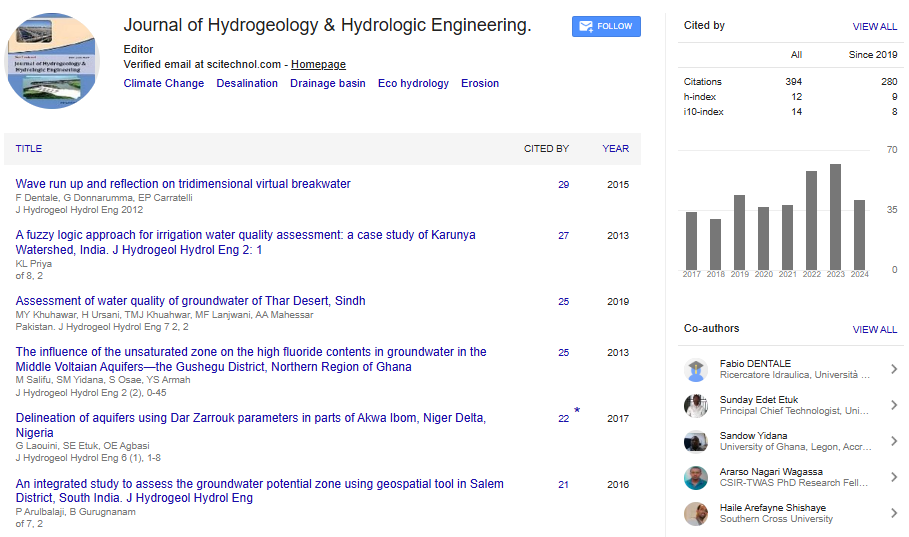Opinion Article, J Hydrogeol Hydrol Eng Vol: 13 Issue: 1
The Power of Hydroinformatics: A Comprehensive Guide to Analyzing Water Data
Yusuf Sermet*
1Department of Environmental Engineering, Ludong University, Yantai, China
*Corresponding Author: Yusuf Sermet,
Department of Environmental Engineering,
Ludong University, Yantai, China
E-mail: sermety@gmail.com
Received date: 22 January, 2024, Manuscript No. JHHE-24-132071;
Editor assigned date: 24 January, 2024, PreQC No. JHHE-24-132071 (PQ);
Reviewed date: 08 February, 2024, QC No. JHHE-24-132071;
Revised date: 16 February, 2024, Manuscript No. JHHE-24-132071 (R);
Published date: 23 February, 2024, DOI: 10.4172/2325-9647.1000308
Citation: Sermet Y (2024) The Power of Hydroinformatics: A Comprehensive Guide to Analyzing Water Data. J Hydrogeol Hydrol Eng 13:1.
Description
Hydroinformatics, the branch of science that deals with the application of computer science and mathematical methods to solve problems in the field of hydrology, has emerged as an essential tool for managing water resources sustainably. With the increasing availability of water data and the advancements in computational power, hydroinformatics has become a powerful tool for analyzing water data and making informed decisions. This guide provides an in-depth overview of hydroinformatics, its applications, techniques, and tools, highlighting its potential to revolutionize the way we manage water resources.
Hydroinformatics is a multidisciplinary field that combines the principles of computer science, mathematics, and engineering to analyze and solve complex hydrological problems. The term "hydroinformatics" was first used by and since then, it has gained significant attention as a tool for managing water resources sustainably.
Applications of hydroinformatics
Hydroinformatics has numerous applications in different fields, including:
Water resources management: Hydroinformatics can help manage water resources sustainably by analyzing data on water availability, demand, and quality. This information can be used to develop water resource management plans that ensure equitable distribution of water while protecting the environment.
Flood management: Hydroinformatics can help predict and manage floods by analyzing data on rainfall, river discharge, and water levels. This information can be used to develop early warning systems and flood management plans that minimize the impact of floods on communities and infrastructure.
Water quality management: Hydroinformatics can help monitor and manage water quality by analyzing data on water chemistry, water temperature, and other parameters. This information can be used to develop strategies for improving water quality and minimizing the impact of pollution on aquatic ecosystems.
Techniques and tools of hydroinformatics
Hydroinformatics employs a range of techniques and tools to analyze water data, including:
Geographical Information Systems (GIS): GIS is a computerbased tool that captures and analyzes spatial data on water resources. GIS can be used to create detailed maps of water bodies, identify areas of high water quality, and study the impact of human activities on water resources.
Remote sensing: Remote sensing is a technique that uses satellite or aerial imagery to collect data on water bodies and their surrounding environments. Remote sensing can be used to monitor water quality, assess the impact of climate change on water resources, and identify areas of high water demand.
Computational hydrology: Computational hydrology is the application of mathematical and computational techniques to study the movement of water through rivers, groundwater, and other water bodies. Computational hydrology can be used to predict water flow, risk of flooding, and water quality, among other things.
Data mining and machine learning: Data mining and machine learning are techniques that can be used to analyze large datasets on water resources and identify patterns and trends. These techniques can be used to predict water demand, identify areas of water scarcity, and optimize water management strategies.
Benefits of hydroinformatics
Hydroinformatics offers several benefits, including:
Improved water management: Hydroinformatics can help manage water resources sustainably by providing decision-makers with accurate and timely data on water availability, demand, and quality.
Enhanced flood management: Hydroinformatics can help predict and manage floods by providing early warning systems and flood management plans that minimize the impact of floods on communities and infrastructure.
Better water quality management: Hydroinformatics can help monitor and manage water quality by identifying areas of high water pollution and developing strategies for improving water quality.
Cost savings: Hydroinformatics can help reduce costs associated with water management by identifying areas of high water demand and optimizing water use.
 Spanish
Spanish  Chinese
Chinese  Russian
Russian  German
German  French
French  Japanese
Japanese  Portuguese
Portuguese  Hindi
Hindi 
